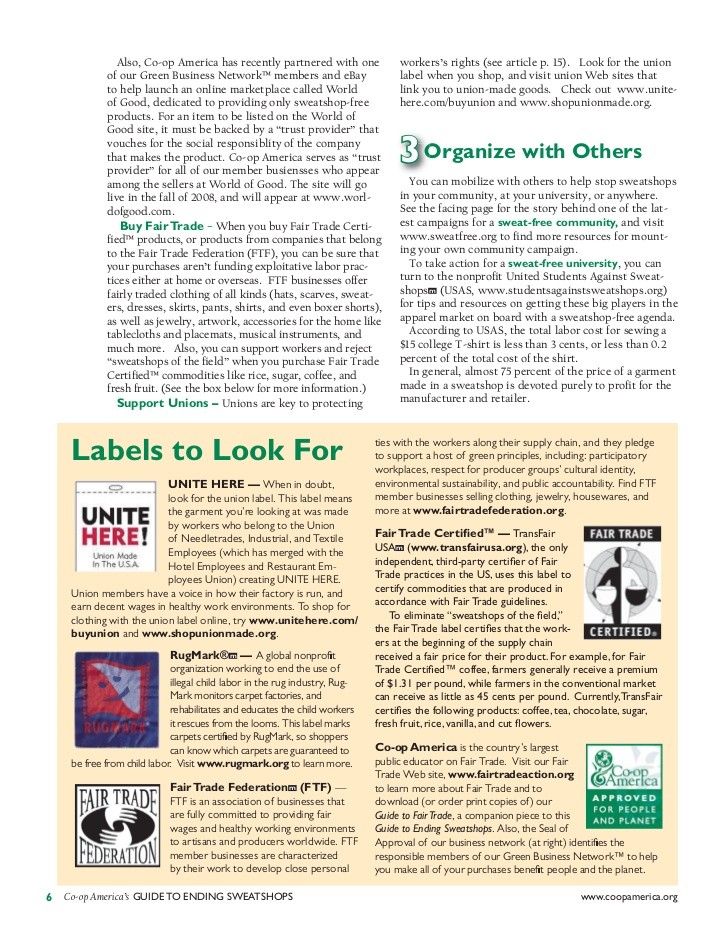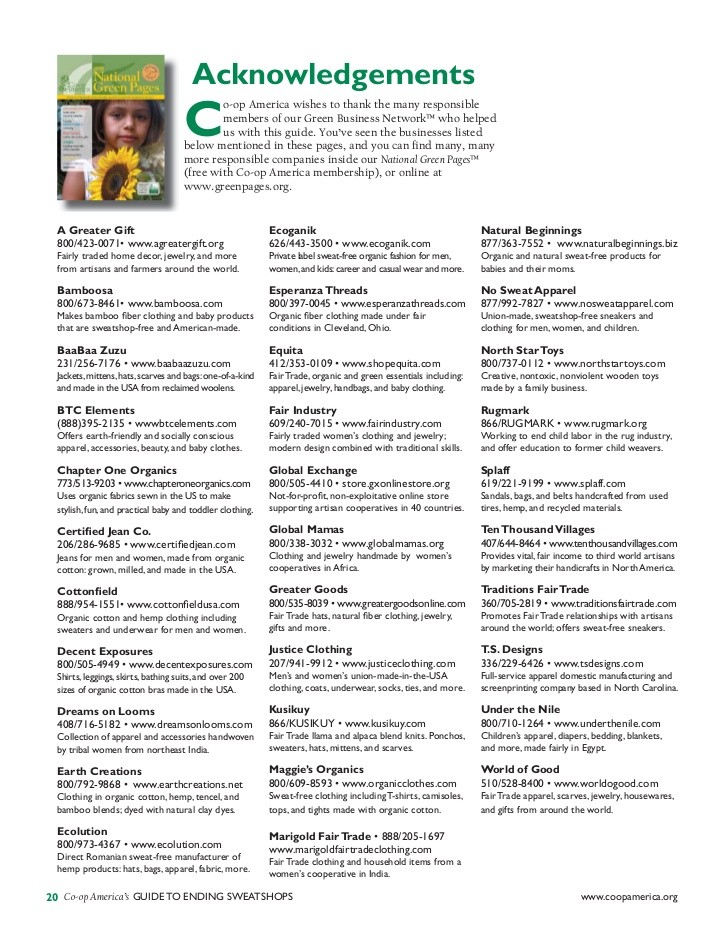Green America s Ending Sweatshops Program What You Can Do
Post on: 21 Апрель, 2015 No Comment

What You Can Do
Through the purchases you make, and those you choose to avoid, you have the power to create an economy where child labor and sweatshops cease to exist.
And your voice, together with the voices of others, can help encourage companies here and abroad to ensure that all workers are paid fairly and treated with respect.
2. Buy union-made, local, and secondhand
For clothing and household items, check out your local secondhand or consignment stores. When buying new clothing, look for the union label on the clothing you buy, or make your purchases from the socially responsible businesses listed in the National Green Pages .
Fair Trade is an economic system that ensures healthy working conditions, self-determination, and fair wages for workers. When you purchase Fair Trade products, you help ensure a sustainable livelihood for farmers and workers. Look for coffee, tea, chocolate/cocoa, bananas, mangoes, pineapples and other fresh fruit bearing the Fair Trade Certified label. If your supermarket or local health food store doesn’t stock fair trade products, ask them to do so and explain why. At restaurants, suggest the addition of Fair Trade Certified coffee and tea to the menu. Also Fair Trade Certified sugar is now available as well.
You can also buy crafts, clothing, jewelry, and other household and gift items from companies that belong to the Fair Trade Federation (FTF).
Learn more about Fair Trade
4. Ask questions
If you are unsure about whether or not a company is working to transform the factories that make their products into places where people are paid a living wage and treated fairly, then ASK.
Use our Consumer Checklist below to help you write a letter or send an email to a company asking about their sourcing practices. If the company does not have good answers for these questions, it is not doing enough to stop sweatshops.
Does your store know how the workers who made this product were treated?
Do you have a list of all the factories around the world that make your products? Does it include the wages and working conditions in each factory? Can you provide me with a copy of it?
Does your store guarantee that the workers who made this product were paid a living wage, enough to support their families?
Does your store have a code of conduct that protects human rights and forbids child labor and unsafe conditions in all the factories that make the products you sell? How do you enforce these rules? Are your factories monitored by independent, third-party sources?
Are you providing development programs in the communities where your workers live? Are you working with others in your industry to apply meaningful labels so consumers can know that exploited labor was not used to make your product?
5. Mobilize in at your workplace, school, or in your community
Encourage local businesses to source sweatshop-free products. Work with your coworkers to ensure that the company t-shirts are sweat-free. Work with members of your faith community to develop a sweatshop-free purchasing policy. If you are a student or affiliated with a university, demand that your institution buy items such as uniforms, sporting equipment, and other goods from companies that monitor conditions along the supply chain and guard against employee abuse at all stages of production.

Get a free copy of Green America’s Guide to Ending Sweatshop s to help you with your efforts. Bulk pricing is available. Call 1-800-58-GREEN to order.
6. Use shareholder clout
If you own stock in individual companies, check the proxy ballots that you get in the mail and be sure to vote in support of any shareholder resolutions that require the company to improve its labor policies.
Also, if you put money into mutual funds, your investments can still work to improve the way companies treat their employees. Some mutual funds refuse to invest in companies that demonstrate indifference to workers’ welfare, while others engage in the practice of shareholder action to get companies in which they invest to improve their labor practices. Over the past few years, mutual funds such as Calvert and Domini Social Investments have been working to get companies such as Dillard’s and Wal-Mart to adopt policies designed to ensure that their products aren’t being made under sweatshop conditions.
To find a mutual fund that screens out companies with bad labor practices or engages in shareholder advocacy, consult the financial planning section of Green America’s National Green Pages . You can also order a copy of Green America’s Guide to Shareholder Action for a small fee. Call 1-800-58-GREEN.
7. Educate Others
Let the people around you know what they can do to put an end to sweatshops. Send an email to your friends letting them know about this online resource.
One way to spread the word is by giving your friends and family gift memberships to Green America. They’ll receive a free copy of the National Green Pages with their membership to help put them on the road to sweatshop-free purchasing.
Learn how you can find sweat-free and Fair Trade products














